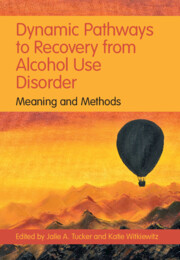Book contents
- Dynamic Pathways to Recovery from Alcohol Use Disorder
- Dynamic Pathways to Recovery from Alcohol Use Disorder
- Copyright page
- Dedication
- Contents
- Figures
- Tables
- Contributors
- Foreword
- Preface
- Acknowledgments
- Introduction
- Part I Micro Level
- Part II Meso Level
- Part III Macro Level
- 16 Recovery Communities
- 17 Disparities in Alcohol Treatment Access in Rural Areas
- 18 Recovery, Communities, and the Organized Recovery Movement
- 19 Alcohol Control Policy and Regulations to Promote Recovery from Alcohol Use Disorder
- 20 Causal Inference Approaches to Studying Recovery from Alcohol Use Disorder
- 21 Building on Collaborative Research to Co-Design SURE Recovery, a Mobile Application for People with Experience of Alcohol and Other Drug Problems
- 22 Economic Methods Used to Evaluate Recovery Programs for Alcohol Use Disorder
- Conclusions and Future Directions
- Index
- References
20 - Causal Inference Approaches to Studying Recovery from Alcohol Use Disorder
from Part III - Macro Level
Published online by Cambridge University Press: 23 December 2021
- Dynamic Pathways to Recovery from Alcohol Use Disorder
- Dynamic Pathways to Recovery from Alcohol Use Disorder
- Copyright page
- Dedication
- Contents
- Figures
- Tables
- Contributors
- Foreword
- Preface
- Acknowledgments
- Introduction
- Part I Micro Level
- Part II Meso Level
- Part III Macro Level
- 16 Recovery Communities
- 17 Disparities in Alcohol Treatment Access in Rural Areas
- 18 Recovery, Communities, and the Organized Recovery Movement
- 19 Alcohol Control Policy and Regulations to Promote Recovery from Alcohol Use Disorder
- 20 Causal Inference Approaches to Studying Recovery from Alcohol Use Disorder
- 21 Building on Collaborative Research to Co-Design SURE Recovery, a Mobile Application for People with Experience of Alcohol and Other Drug Problems
- 22 Economic Methods Used to Evaluate Recovery Programs for Alcohol Use Disorder
- Conclusions and Future Directions
- Index
- References
Summary
This chapter highlights methods for estimating causality in the health and behavioral sciences, with an emphasis on methods that have been utilized in the study of recovery from alcohol use disorder. Emphasis is placed on the role of design as a necessary component in teasing out causal relationships, with the ideal approach being an experimental approach with a randomization component. In the absence of experimental design, researchers often turn to observational studies. In such cases, it is necessary to turn to quasi-experimental designs, two of which are highlighted herein: regression discontinuity and interrupted time series designs. Additionally, disadvantages of propensity scores are discussed, psychometric network modeling is described, and software packages for implementing these methods are highlighted.
Keywords
- Type
- Chapter
- Information
- Dynamic Pathways to Recovery from Alcohol Use DisorderMeaning and Methods, pp. 364 - 379Publisher: Cambridge University PressPrint publication year: 2022



